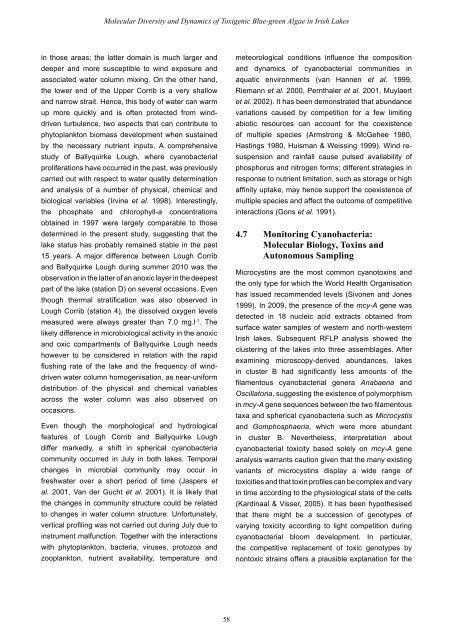STRIVE - Environmental Protection Agency
STRIVE - Environmental Protection Agency
STRIVE - Environmental Protection Agency
You also want an ePaper? Increase the reach of your titles
YUMPU automatically turns print PDFs into web optimized ePapers that Google loves.
Molecular Diversity and Dynamics of Toxigenic Blue-green Algae in Irish Lakes<br />
in those areas; the latter domain is much larger and<br />
deeper and more susceptible to wind exposure and<br />
associated water column mixing. On the other hand,<br />
the lower end of the Upper Corrib is a very shallow<br />
and narrow strait. Hence, this body of water can warm<br />
up more quickly and is often protected from winddriven<br />
turbulence, two aspects that can contribute to<br />
phytoplankton biomass development when sustained<br />
by the necessary nutrient inputs. A comprehensive<br />
study of Ballyquirke Lough, where cyanobacterial<br />
proliferations have occurred in the past, was previously<br />
carried out with respect to water quality determination<br />
and analysis of a number of physical, chemical and<br />
biological variables (Irvine et al. 1998). Interestingly,<br />
the phosphate and chlorophyll-a concentrations<br />
obtained in 1997 were largely comparable to those<br />
determined in the present study, suggesting that the<br />
lake status has probably remained stable in the past<br />
15 years. A major difference between Lough Corrib<br />
and Ballyquirke Lough during summer 2010 was the<br />
observation in the latter of an anoxic layer in the deepest<br />
part of the lake (station D) on several occasions. Even<br />
though thermal stratification was also observed in<br />
Lough Corrib (station 4), the dissolved oxygen levels<br />
measured were always greater than 7.0 mg.l-1 . The<br />
likely difference in microbiological activity in the anoxic<br />
and oxic compartments of Ballyquirke Lough needs<br />
however to be considered in relation with the rapid<br />
flushing rate of the lake and the frequency of winddriven<br />
water column homogenisation, as near-uniform<br />
distribution of the physical and chemical variables<br />
across the water column was also observed on<br />
occasions.<br />
Even though the morphological and hydrological<br />
features of Lough Corrib and Ballyquirke Lough<br />
differ markedly, a shift in spherical cyanobacteria<br />
community occurred in July in both lakes. Temporal<br />
changes in microbial community may occur in<br />
freshwater over a short period of time (Jaspers et<br />
al. 2001, Van der Gucht et al. 2001). It is likely that<br />
the changes in community structure could be related<br />
to changes in water column structure. Unfortunately,<br />
vertical profiling was not carried out during July due to<br />
instrument malfunction. Together with the interactions<br />
with phytoplankton, bacteria, viruses, protozoa and<br />
zooplankton, nutrient availability, temperature and<br />
58<br />
meteorological conditions influence the composition<br />
and dynamics of cyanobacterial communities in<br />
aquatic environments (van Hannen et al. 1999,<br />
Riemann et al. 2000, Pernthaler et al. 2001, Muylaert<br />
et al. 2002). It has been demonstrated that abundance<br />
variations caused by competition for a few limiting<br />
abiotic resources can account for the coexistence<br />
of multiple species (Armstrong & McGehee 1980,<br />
Hastings 1980, Huisman & Weissing 1999). Wind resuspension<br />
and rainfall cause pulsed availability of<br />
phosphorus and nitrogen forms; different strategies in<br />
response to nutrient limitation, such as storage or high<br />
affinity uptake, may hence support the coexistence of<br />
multiple species and affect the outcome of competitive<br />
interactions (Gons et al. 1991).<br />
4.7 Monitoring Cyanobacteria:<br />
Molecular Biology, Toxins and<br />
Autonomous Sampling<br />
Microcystins are the most common cyanotoxins and<br />
the only type for which the World Health Organisation<br />
has issued recommended levels (Sivonen and Jones<br />
1999). In 2009, the presence of the mcy-A gene was<br />
detected in 18 nucleic acid extracts obtained from<br />
surface water samples of western and north-western<br />
Irish lakes. Subsequent RFLP analysis showed the<br />
clustering of the lakes into three assemblages. After<br />
examining microscopy-derived abundances, lakes<br />
in cluster B had significantly less amounts of the<br />
filamentous cyanobacterial genera Anabaena and<br />
Oscillatoria, suggesting the existence of polymorphism<br />
in mcy-A gene sequences between the two filamentous<br />
taxa and spherical cyanobacteria such as Microcystis<br />
and Gomphosphaeria, which were more abundant<br />
in cluster B. Nevertheless, interpretation about<br />
cyanobacterial toxicity based solely on mcy-A gene<br />
analysis warrants caution given that the many existing<br />
variants of microcystins display a wide range of<br />
toxicities and that toxin profiles can be complex and vary<br />
in time according to the physiological state of the cells<br />
(Kardinaal & Visser, 2005). It has been hypothesised<br />
that there might be a succession of genotypes of<br />
varying toxicity according to light competition during<br />
cyanobacterial bloom development. In particular,<br />
the competitive replacement of toxic genotypes by<br />
nontoxic strains offers a plausible explanation for the

















